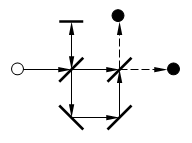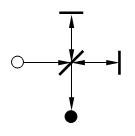Interference
| Previous chapter ( Sagnac effect ) | Table of contents | Next chapter ( Radio waves ) |
Corresponding Wikipedia article: Interference
Definitions
The interference relates to the mechanical (acoustic), the magnetic waves, and the light beams. The unique properties of the light beams are considered further.
The interferometer is an optical system, which consists of the source of coherent radiation, the radiation receiver, and the reflecting surfaces (mirrors), which are the secondary beam sources together with the primary source. The modification of the received interference pattern occurs due to the various reasons.
The optical interference pattern is generated as a superposition of the electromagnetic fields of the beams. The beams are propagating independently from each other in all directions: transversely, opposite and parallel. The magnetic (electric) interaction energy of the straight beams has no sense, since only the vortical field has a non-zero magnetic force. The interference manifests by a net force of the beams, which acts on the material particles. The energy of this force does not exceed the own energy of the beams.
The complete destructive interference is a superposition of two identical parallel beams in opposite phase. In this case, both beams conserve their energy, but their net force is zero.
Michelson–Morley experiment
The Michelson's interferometer contains one semitransparent mirror, which splits the beams, propagating and reflecting from the mirrors in opposite directions.
The wavelength is constant and equal for all the beams regardless of their speed, which depend on the system speed with respect to the absolute reference frame. These speeds are also varying as in the measurement of the speed of light. Thus, the desired "aetheric wind" does not appear in the receiver at any measurement accuracy.
This experiment is neither a proof of the aether absence nor a proof of the speed of light invariance with respect to any frame.
Sagnac interferometer
The Sagnac interferometer is a gyroscopic angular speed sensor, which is based on the same effect and is able to measure the speed of its rotation with respect to an inertial reference frame. Two opposing beams propagate over the annular system of the mirrors or the optical fiber, and are interfered at the receiver. Thus, some optical errors are offsetting. The sensor rotation alters the beam path lengths with the different increment signs and, therefore, alters the amplitude of their sum.
The Doppler effect is compensated in all directions of any kind of motion. In case of the optical fiber, the light is not entangled by the moving medium, because it moves together with the source and the receiver.
Fizeau experiment
The Fizeau experiment is an example of the Doppler effect in the moving water with the stationary source and receiver. The actual path length of a beam in time \(T\), at a speed of \(v'\), in the water column of length \(L\), with the flow speed \(V\), is: \[L\mp VT=v'T\tag{1}\] The water particles are the secondary beam sources due to the scattering. The longitudal Doppler effect ("Doppler effect", 5) emerges when the beam enters the water, which has a refractive index \(n\), and is equivalent to the beam velocity varying: \[v'=\frac{1}{n}\left(c\mp\frac{V}{n}\right)\tag{2}\] The speed of a beam, which passes through the flowing water, is expressed by the known, experimentally proven, equation: \[v=\frac{L}{T}=v'\pm V=\frac{c}{n}\pm V\left(1-\frac{1}{n^2}\right)\tag{3}\]
| Previous chapter ( Sagnac effect ) | Table of contents | Next chapter ( Radio waves ) |

